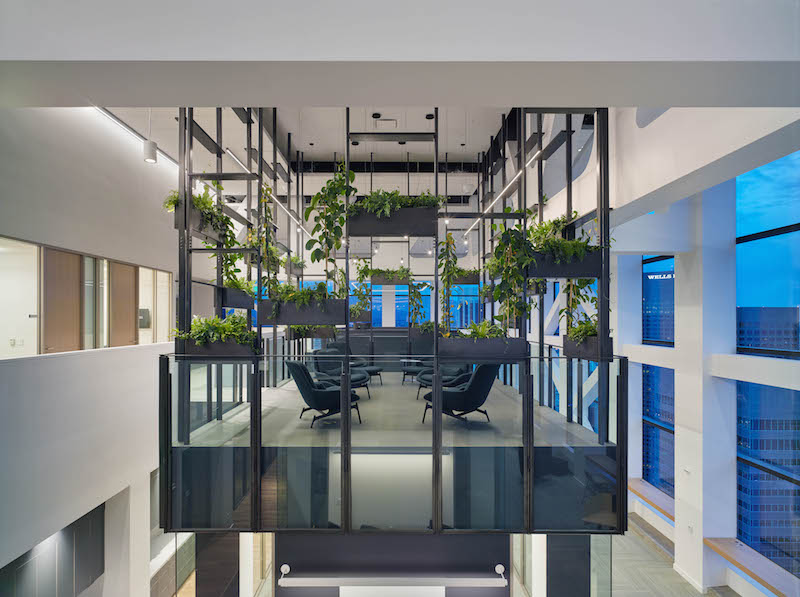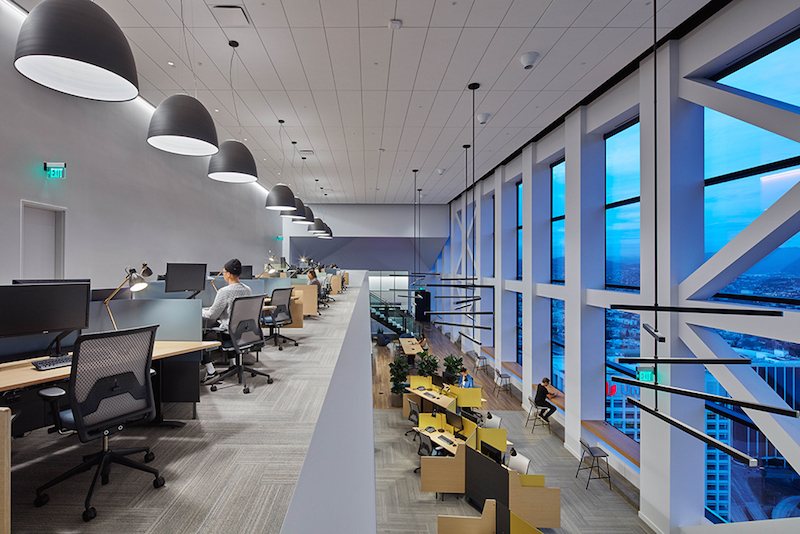When Joe Lozowski took over Tangram Interiors about 15 years ago, the Los Angeles-based distributor of office furniture was down on its heels. “Just being a furniture provider was not an exciting story,” recalls Lozowski about a company that dates back to 1963.
So the first thing he did after assuming control was to reach out to architects, designers, and clients about what they wanted from companies like his.
Fast forward to the present: Tangram Interiors has six furniture dealerships in southern California and 300 employees. It is the area’s second-largest flooring contractor. And under Lozowski’s leadership, Tangram has diversified into furniture customization (more than 40 of its employees are designers), fabrication, technology, and a “move management” business called Tangram Onsite.
Tangram Interiors’ revenue is expected to hit $180 million in 2017, from $127 million in 2014. (Add another $20 million or so from direct sales via Steelcase, its main furniture supplier.) Its growth engines are a custom furniture division Tangram Studio, which Lozowski started in 2004, and whose sales are projected to reach $12 million in 2017, from $7.75 million in 2014; and Tangram Technology, started in 2013, which is on pace to hit $5 million in revenue this year from $2.3 million in its first full year in operation.
Lozowski, 58, the company’s president and CEO, says his goal this year is to expand its Studio brand to a national level. He told GlobeSt.com that Tangram currently is installing projects for clients in Seattle (where it’s working with Juno Therapeutics, a biotech firm, to co-design furniture for 12 floors and build technology into that furniture), Portland, San Francisco, Dallas, Chicago, and New York.
Lozowski recalls that his company’s path toward diversification began when, around the time he took over Tangram Interiors, he was approached by a client who wanted furniture “that looked like it was made at Home Depot,” with a rough-hewn, DIY appearance. He accepted that commission, which got him thinking “maybe this is something we can make a business from.”
Tangram Interiors is not an interior design firm, Lozowski explains. Its design team, which includes 45 consultants, works with manufacturers, as well as its clients' designers, architects, engineers, and project managers to develop schematics for resilient workplaces, a concept borrowed from Steelcase that views office space as an adaptable ecosystem that evolves over time. Its principles revolve around design for wellbeing and providing employees with ranges of options within the workplace.
 Boston Consulting Group's offices in downtown Los Angeles include 30 meeting rooms and 24 private offices. Image: Courtesy Tangram Interiors.
Boston Consulting Group's offices in downtown Los Angeles include 30 meeting rooms and 24 private offices. Image: Courtesy Tangram Interiors.
Tangram Interiors’ client list includes Perkins + Will, Loyola Marymount College (with which it has worked for 10 years), Hulu, Brookfield Residential, Experian, Intuit, and UCLA Health. Tangram Studio helped with the furniture design for Tangram Interiors’ headquarters. (Lokowski refers to his showrooms as “learning labs.”)
Among Tangram Studio’s more recent projects is its collaboration with Boston Consulting Group (BCG) and the design firm Shubin Donaldson to create a new concept for the 45,000 sf of office space that BCG occupies in the north tower of City National Plaza in downtown Los Angeles. Tangram Studio’s research discovered that most of BCG’s consultants were in the office only 25% of the time. So its design solution includes 130 traditional workstations and 80 “touchdown” spaces with standing height stations incorporated into metal railings, lounge seating, and semi-private spaces throughout the office.
The design for this project includes 24 private offices and 30 meeting rooms within the office interior, leaving the perimeter open to allow for better outside views.
Lozowski started Tangram Technology after hearing from clients about how they couldn’t find reliable contractors that could coordinate the details between office design and technology. He says that, except for two big providers, this sector remains highly fragmented. Opportunities lie in the fact that “beside your chair, there’s nothing in an office that isn’t attached to a wire.”
Lozowski observes that most office designs lack “vision” because too many clients are still focused on what’s the least they can spend. He says the key to successful office furniture design is “mass customization.” And what’s winning clients over the Tangram Interiors is “that people love we’re co-designing with them.”
Related Stories
Fire and Life Safety | Jan 9, 2023
Why lithium-ion batteries pose fire safety concerns for buildings
Lithium-ion batteries have become the dominant technology in phones, laptops, scooters, electric bikes, electric vehicles, and large-scale battery energy storage facilities. Here’s what you need to know about the fire safety concerns they pose for building owners and occupants.
Cladding and Facade Systems | Dec 20, 2022
Acoustic design considerations at the building envelope
Acentech's Ben Markham identifies the primary concerns with acoustic performance at the building envelope and offers proven solutions for mitigating acoustic issues.
Sponsored | Resiliency | Dec 14, 2022
Flood protection: What building owners need to know to protect their properties
This course from Walter P Moore examines numerous flood protection approaches and building owner needs before delving into the flood protection process. Determining the flood resilience of a property can provide a good understanding of risk associated costs.
HVAC | Dec 13, 2022
Energy Management Institute launches online tool to connect building owners with HVAC contractors
The National Energy Management Institute Inc. (NEMI) along with the Biden administration’s Better Air in Buildings website have rolled out a resource to help building owners and managers, school districts, and other officials find HVAC contractors.
Adaptive Reuse | Dec 9, 2022
What's old is new: Why you should consider adaptive reuse
While new construction allows for incredible levels of customization, there’s no denying that new buildings can have adverse impacts on the climate, budgets, schedules and even the cultural and historic fabrics of communities.
High-rise Construction | Dec 7, 2022
SOM reveals its design for Singapore’s tallest skyscraper
Skidmore, Owings & Merrill (SOM) has revealed its design for 8 Shenton Way—a mixed-use tower that will stand 63 stories and 305 meters (1,000 feet) high, becoming Singapore’s tallest skyscraper. The design team also plans to make the building one of Asia’s most sustainable skyscrapers. The tower incorporates post-pandemic design features.
Office Buildings | Dec 7, 2022
Software giant SAP opens engineering academy for its global engineering workforce
Software giant SAP has opened its new SAP Academy for Engineering on the company’s San Ramon, Calif. campus. Designed by HGA, the Engineering Academy will provide professional development opportunities for SAP’s global engineering workforce. At the Engineering Academy, cohorts from SAP offices across the globe will come together for intensive, six-month training programs.
Office Buildings | Dec 6, 2022
‘Chicago’s healthiest office tower’ achieves LEED Gold, WELL Platinum, and WiredScore Platinum
Goettsch Partners (GP) recently completed 320 South Canal, billed as “Chicago’s healthiest office tower,” according to the architecture firm. Located across the street from Chicago Union Station and close to major expressways, the 51-story tower totals 1,740,000 sf. It includes a conference center, fitness center, restaurant, to-go market, branch bank, and a cocktail lounge in an adjacent structure, as well as parking for 324 cars/electric vehicles and 114 bicycles.
Mixed-Use | Dec 6, 2022
Houston developer plans to convert Kevin Roche-designed ConocoPhillips HQ to mixed-use destination
Houston-based Midway, a real estate investment, development, and management firm, plans to redevelop the former ConocoPhillips corporate headquarters site into a mixed-use destination called Watermark District at Woodcreek.
Office Buildings | Dec 5, 2022
How to foster collaboration and inspiration for a workplace culture that does not exist (yet)
A building might not be able to “hack” innovation, but it can create the right conditions to foster connection and innovation, write GBBN's Chad Burke and Zachary Zettler.
















